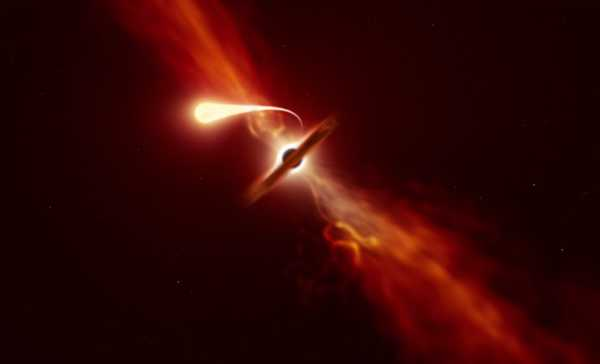Oct 13 2020
Researchers have used telescopes from across the globe to observe a rare burst of light from a star as it is gobbled by a supermassive black hole.

Image Credit: ESO/M. Kornmesser.
Dubbed a tidal disruption event, the phenomenon is the closest flare of its type to be recorded so far and occurred just 215 million light-years from Earth. The phenomenon occurs when a star comes too close to a black hole and is shredded into thin streams of material by the extreme gravitational pull of the black hole—a process known as “spaghettification.”
When the process takes place, some of the material from the star tends to fall into the black hole, which leads to the emission of a bright flare of energy that can be detected by astronomers.
Tidal disruption events occur rarely and are not easy to analyze since they are often masked by a veil of dust and debris. Led by the University of Birmingham, an international group of researchers could explore this event in unmatched detail as it was found shortly after the star was ripped apart.
The researchers used the European Southern Observatory’s Very Large Telescope and New Technology Telescope, the Las Cumbres Observatory global telescope network, and the Neil Gehrel’s Swift Satellite and could monitor the flare, called AT2019qiz, for a period of six months as it became brighter and faded away eventually.
The findings of the study have been reported in Monthly Notices of the Royal Astronomical Society. The study was backed and financially supported partially by the Science and Technology Facilities Council (STFC).
The idea of a black hole ‘sucking in’ a nearby star sounds like science fiction. But this is exactly what happens in a tidal disruption event. We were able to investigate in detail what happens when a star is eaten by such a monster.
Dr Matt Nicholl, Study Lead Author, Lecturer and Royal Astronomical Society Research Fellow, University of Birmingham
“When a black hole devours a star, it can launch a powerful blast of material outwards that obstructs our view,” explained Samantha Oates, who is also from the University of Birmingham. “This happens because the energy released as the black hole eats up stellar material propels the star’s debris outwards.”
Astronomers could identify the phenomenon of the AT2019qiz flare quite early to view the entire process.
Several sky surveys discovered emission from the new tidal disruption event very quickly after the star was ripped apart. We immediately pointed a suite of ground-based and space telescopes in that direction to see how the light was produced.
Thomas Wevers, ESO Fellow, Santiago, Chile
Wevers was part of the Institute of Astronomy, University of Cambridge, UK, when he performed the study. The quick and comprehensive observations in optical, ultraviolet, radio, and X-ray light unraveled, like never before, a direct link between the material that flows out from the star and the bright flare released as it is gobbled by the black hole.
“The observations showed that the star had roughly the same mass as our own Sun and that it lost about half of that to the black hole, which is over a million times more massive,” noted Nicholl, who is also a visiting researcher at the University of Edinburgh.
Because we caught it early, we could actually see the curtain of dust and debris being drawn up as the black hole launched a powerful outflow of material with velocities up to 10 000 km/s. This unique ‘peek behind the curtain’ provided the first opportunity to pinpoint the origin of the obscuring material and follow in real time how it engulfs the black hole.
Kate Alexander, NASA Einstein Fellow, Northwestern University
The study enables astronomers to gain better insights into supermassive black holes and the behavior of matter in the intense gravity environments surrounding them. According to the team members, AT2019qiz could even serve as a “Rosetta stone” to decipher forthcoming observations of tidal disruption events.
The Extremely Large Telescope (ELT) of the ESO, which has been scheduled to start running this decade, will allow scientists to find tidal disruption events that are fainter and evolve much faster, to find solutions to further mysteries of black hole physics.
Journal Reference:
Nicholl, M., et al. (2020) An outflow powers the optical rise of the nearby, fast-evolving tidal disruption event AT2019qiz. Monthly Notices of the Royal Astronomical Society. doi.org/10.1093/mnras/staa2824.